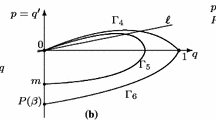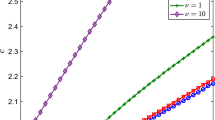Abstract
We consider a reaction–diffusion–advection equation of the form: \(u_t=u_{xx}-\beta (t)u_x+f(t,u)\) for \(x\in (g(t),h(t))\), where \(\beta (t)\) is a T-periodic function representing the intensity of the advection, f(t, u) is a Fisher–KPP type of nonlinearity, T-periodic in t, g(t) and h(t) are two free boundaries satisfying Stefan conditions. This equation can be used to describe the population dynamics in time-periodic environment with advection. Its homogeneous version (that is, both \(\beta \) and f are independent of t) was recently studied by Gu et al. (J Funct Anal 269:1714–1768, 2015). In this paper we consider the time-periodic case and study the long time behavior of the solutions. We show that a vanishing–spreading dichotomy result holds when \(\beta \) is small; a vanishing–transition–virtual spreading trichotomy result holds when \(\beta \) is a medium-sized function; all solutions vanish when \(\beta \) is large. Here the partition of \(\beta (t)\) depends not only on the “size” \(\bar{\beta }:= \frac{1}{T}\int _0^T \beta (t) dt\) of \(\beta (t)\) but also on its “shape” \(\tilde{\beta }(t) := \beta (t) - \bar{\beta }\).
Similar content being viewed by others
Notes
In [5], \(f\in C^2\) is assumed and \(v\rightarrow U_1\) is taken in \(H^2 ([0,\ell ])\). Note that for our problem (3.3), the assumption for f and k is sufficient to guarantee that the omega limit set of \(v(t,\cdot )\) in the topology \(C^2 ([0,\ell ])\) is not empty, and then a similar zero number argument as in [5] gives the convergence \(v\rightarrow U_1\) in \(C^2 ([0,\ell ])\). Moreover, the zero number properties we used here are those in Angenent [1], where the coefficient k(t) of \(v_z\) is assumed to be in \(W^{1,\infty }([0,T])\). We remark that for our problem, the condition \(k\in C^{\nu /2}([0,T])\) is sufficient to proceed the zero number argument. In fact, denote \(K(t):= \int _0^t k(s)ds\), \(y:= z+K(t)\) and \(w(t,y):= v(t, y-K(t))\), then the equation of v is converted into \(w_t = w_{yy} + f(t,w)\). This equation has no the first order term, though it is considered in a moving frame \(K(t)< y < K(t) +\ell \), the zero number properties as in [1] remain valid (cf. [11, 17]). In Sect. 5.2, we use the zero number properties in the same way.
Note that [19, Proposition 2.3] holds for the equation \(u_t =u_{xx} + au\) with \(a>0\) being a constant. If \(a=a(t)\) is a periodic function with \(\bar{a} >0\), then the function \(w:= ue^{-\int _0^t [a(s) -\bar{a}] ds}\) satisfies \(w_t =w_{xx} + \bar{a}w\), and so the conclusions in [19, Proposition 2.3] hold for w.
References
Angenent, S.B.: The zero set of a solution of a parabolic equation. J. Reine Angew. Math. 390, 79–96 (1988)
Aronson, D.G., Weinberger, H.F.: Nonlinear diffusion in population genetics, combustion, and nerve pulse propagation. In: Goldstein J.A. (eds) Partial Differential Equations and Related Topics. Lecture Notes in Mathematics, vol. 446, pp. 5–49. Springer, Berlin, Heidelberg (1975). doi:10.1007/BFb0070595
Aronson, D.G., Weinberger, H.F.: Multidimensional nonlinear diffusion arising in population genetics. Adv. Math. 30, 33–76 (1978)
Berestycki, H., Hamel, F., Nadin, G.: Asymptotic spreading in heterogeneous diffusive excitable media. J. Funct. Anal. 255, 2146–2189 (2008)
Brunovský, P., Poláčik, P., Sandstede, B.: Convergence in general periodic parabolic equations in one space dimension. Nonlinear Anal. 18, 209–215 (1992)
Bunting, G., Du, Y., Krakowski, K.: Spreading speed revisited: analysis of a free boundary model. Netw. Heterog. Media 7, 583–603 (2012)
Chen, X., Friedman, A.: A free boundary problem arising in a model of wound healing. SIAM J. Math. Anal. 32, 778–800 (2000)
Du, Y., Guo, Z.M., Peng, R.: A diffusion logistic model with a free boundary in time-periodic environment. J. Funct. Anal. 265, 2089–2142 (2013)
Du, Y., Lin, Z.: Spreading-vanishing dichtomy in the diffusive logistic model with a free boundary. SIAM J. Math. Anal. 42, 377–405 (2010)
Du, Y., Lou, B.: Spreading and vanishing in nonlinear diffusion problems with free boundaries. J. Eur. Math. Soc. 17, 2673–2724 (2015)
Du, Y., Lou, B., Zhou, M.: Nonlinear diffusion problems with free boundaries: convergence, transition speed and zero number arguments. SIAM J. Math. Anal. 47, 3555–3584 (2015)
Du, Y., Matsuzawa, H., Zhou, M.: Sharp estimate of the spreading speed determined by nonlinear free boundary problems. SIAM J. Math. Anal. 46, 375–396 (2014)
Fisher, R.A.: The wave of advance of advantageous genes. Ann. Eugen. 7, 335–369 (1937)
Friedman, A., Hu, B.: Bifurcation from stability to instability for a free boundary problem arising in a tumor model. Arch. Ration. Mech. Anal. 180, 293–330 (2006)
Ge, J., Kim, K., Lin, Z., Zhu, H.: A SIS reaction–diffusion–advection model in a low-risk and high-risk domain. J. Differ. Equ. 259, 5486–5509 (2015)
Gu, H., Lin, Z., Lou, B.: Different asymptotic spreading speeds induced by advection in a diffusion problem with free boundaries. Proc. Am. Math. Soc. 143, 1109–1117 (2015)
Gu, H., Lou, B., Zhou, M.: Long time behavior of solutions of Fisher–KPP equation with advection and free boundaries. J. Funct. Anal. 269, 1714–1768 (2015)
Hamel, F.: Qualitative properties of monostable pulsating fronts: exponential decay and monotonicity. J. Math. Pures Appl. 89, 355–399 (2008)
Hamel, F., Nolen, J., Roquejoffre, J., Ryzhik, L.: A short proof of the logarithmic Bramson correction in Fisher–KPP equations. Netw. Heterog. Media 8, 275–289 (2013)
Hamel, F., Roques, L.: Uniqueness and stability properties of monostable pulsating fronts. J. Eur. Math. Soc. 13, 345–390 (2011)
Hess, P.: Periodic-parabolic Boundary Value Problems and Positivity. Pitman Research Notes in Mathematics, vol. 247. Longman Scientific and Technical, Harlow (1991)
Hilhorst, D., van der Hout, R., Peletier, L.A.: Diffusion in the presence of fast reaction: the case of a general monotone reaction term. J. Math. Sci. Univ. Tokyo 4, 469–517 (1997)
Kolmogorov, A.N., Petrovski, I.G., Piskunov, N.S.: A study of the diffusion equation with increase in the amount of substance, and its application to a biological problem. Bull. Moscow Univ. Math. Mech. 1, 1–25 (1937)
Li, F., Liang, X., Shen, W.: Diffusive KPP equations with free boundaries in time almost periodic environments: I. Spreading and vanishing dichotomy. Discrete Contin. Dyn. Syst. 36, 3317–3338 (2016)
Nadin, G.: Existence and uniqueness of the solution of a space–time periodic reaction–diffusion equation. J. Differ. Equ. 249, 1288–1304 (2010)
Wang, M.X.: A diffusive logistic equation with a free boundary and sign-changing coefficient in time-periodic environment. J. Funct. Anal. 270, 483–508 (2016)
Author information
Authors and Affiliations
Corresponding author
Additional information
Communicated by P. Rabinowitz.
This research was partly supported by NSFC (No. 11671262).
Rights and permissions
About this article
Cite this article
Sun, N., Lou, B. & Zhou, M. Fisher–KPP equation with free boundaries and time-periodic advections. Calc. Var. 56, 61 (2017). https://doi.org/10.1007/s00526-017-1165-1
Received:
Accepted:
Published:
DOI: https://doi.org/10.1007/s00526-017-1165-1




